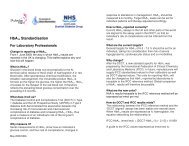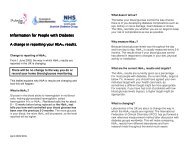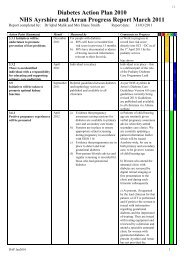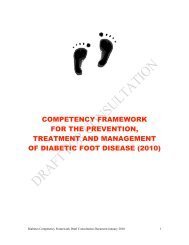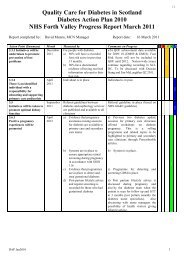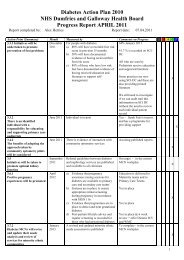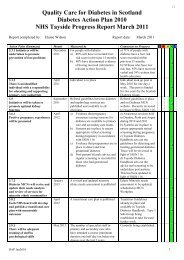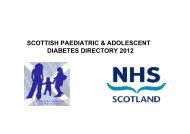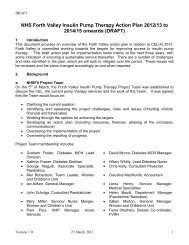DIABETES ACTION PLAN 2010
Diabetes Action Plan 2010 - Scottish Government
Diabetes Action Plan 2010 - Scottish Government
- No tags were found...
Create successful ePaper yourself
Turn your PDF publications into a flip-book with our unique Google optimized e-Paper software.
<strong>DIABETES</strong> <strong>ACTION</strong> <strong>PLAN</strong> <strong>2010</strong><br />
QUALITY CARE FOR <strong>DIABETES</strong> IN SCOTLAND<br />
There is very good evidence that diet and physical activity changes can reduce the risk of<br />
cardiovascular disease and diabetes.<br />
A population strategy for the prevention of cardiovascular disease and for type 2 diabetes<br />
should focus on diet and increased physical activity so that the risk factors are reduced in<br />
the whole population in all age groups.<br />
The Scottish Government Health Directorates are aware of the health impact of all<br />
policies which influence diet and activity. An approach combining the medical model<br />
(screening, detection and treatment of individual people with lifestyle intervention) and<br />
the public health model (changing the behaviour and risks of the population by public<br />
health measures such as promoting healthy eating and physical activity, and hence weight<br />
control) is required. This includes reducing the progression to diabetes of people with<br />
impaired glucose tolerance. 1 The Scottish Government has already identified a national<br />
indicator to ‘reduce the rate of increase in the proportion of children with their body<br />
mass index outwith a healthy range by 2018’. A further indicator is being developed to<br />
cover the whole population, in addition to identifying a series of milestones that must be<br />
met if we are to reverse obesity trends.<br />
Action we will take:<br />
NHS Boards should take account of the Obesity Strategy Route Map<br />
in their work with Community Health Partnerships (CHPs) and NHS<br />
Boards’ planning partners.<br />
Responsibility: Scottish Government Health Directorates, NHS Boards.<br />
Quality Healthcare Dimensions: effective and equitable.<br />
2.2 Screening for type 2 diabetes<br />
Where we want to be:<br />
We want to detect and diagnose diabetes earlier in order to prevent, so far as possible,<br />
complications.<br />
Why we want to be there:<br />
Research shows that there is a long, asymptomatic phase in which the condition can,<br />
however, be detected. Up to 50% of people diagnosed with type 2 diabetes present with<br />
complications at diagnosis. Impaired glucose tolerance (IGT) and non-diabetic<br />
hyperglycaemia (NDH) are associated with increased risk of premature cardiovascular<br />
disease. Early treatment may reduce progression to diabetes.<br />
1 A number of studies of the cost-effectiveness of intervention to reduce progression to diabetes in people with<br />
impaired glucose tolerance have been published. People with impaired glucose tolerance, after an oral glucose<br />
tolerance test, or non-diabetic hyperglycaemia, identified by HbA 1c , should reduce calorie intake to achieve weight<br />
loss, and should increase their levels of physical activity. Most conclude that it is cost-effective, and in some scenarios,<br />
cost saving. One of the key factors in cost-effectiveness analysis is adherence to lifestyle changes.<br />
17




